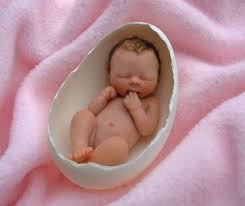Premature Birth
If the baby is born between the 20th and 37th weeks of pregnancy, when the baby is not fully developed yet, this is called premature birth. Labour pains before the 37thweek of pregnancy are also stated as threats for premature birth. About 10% of all new born babies are hasty. They are called premature babies.
The most important complication for premature babies is that they face breathing problems due to underdevelopment of their lungs. Additionally, the earlier the birth takes place the higher the chances of risk regarding possible issues regarding the central nervous system. Prematurity is the most common cause of death regarding new born babies.
The risk decreases with each passing week of pregnancy. In recent years, there have been immense improvements in premature baby treatments and even very early premature babies have more chances of surviving. However, regarding some specific conditions in our country, premature birth still poses some problems. Moreover, care and medical treatment of such babies against possible complications cost a considerably high.
What are the causes of premature birth?
Nearly half of premature births do not have a specific cause. Regarding the other half, some conditions can be diagnosed. The most common ones are infections. An infection source on the mother, especially urinary system infections, can be a serious risk factor.
If the mother has urinary tract infection, there is fivefold risk of premature birth. That’s why during routine pregnancy watch, frequent urine tests and if necessary, infection treatment is suggested.
Vaginal infections can also trigger premature birth. Specifically, when microorganisms damage the amnion membrane and water breaks (premature rupture of membrane) as a consequence, premature labour may start.
Other risk factors;
- History of premature birth (increases risk up to 20-30%),
- miscarriages,
- Chronic diseases the mother has (hypertension, asthma, hyperthyroidism, heart diseases, anemia, diabetes, kidney problems, drug addiction etc.)
- Smoking (twofold increased premature birth risk)
- Mother being too young (younger than 16) or over 35,
- Structural/Formational problems regarding the uterus by birth or forming at later ages (i.e. double uterus, intrauterine septum, having had surgical procedures such as myomectomy)
- Physical trauma the mother has experienced (accidents, surgical operations)
- Insufficient nutrition
- Multiple pregnancies causing excessive stretching of the uterus. Almost half of twins are born before the 36th week of pregnancy. Also in polyhydramnios cases, where the uterus is stretched too much, there is an increased risk of premature birth.
- Conditions regarding the placenta such as placenta previa (when the placenta grows in an abnormal place in the uterus) or placental abruption (abruptio placenta) can also lead to premature birth.
What are the symptoms of premature birth?
Success in preventing premature birth depends on early diagnosis.
First of all, uterine contractions should be noticed. Uterine contractions can be felt by placing your fingers on the abdominal wall. The feeling might be like your uterus squeezing under your abdomens or becoming more contracted or stretched than usual. If contractions are frequent and short, they are important. Initially they are painless. If there are more than 3-4 contractions in an hour, you should inform your doctor.
Other symptoms:
- Pain or ache like menstruation cramps in and around the thighs, groins,
- Aches around the lower back and waists,
- Vaginal discharge or bleeding,
- sudden increase in vaginal discharge,
- vaginal fluid or bloody discharge,
- pressure on pelvis.
Consult your doctor if you have one or more of these symptoms. In the meantime, you can reduce contraction frequency by drinking a lot of water and resting by lying on your left side; thus, increasing uterine circulation.
Diagnosis:
Premature labour is diagnosed by determining uterine contractions. Before the 37th week of pregnancy, if there are 2 contractions every 10 minutes during a 30 minute observation, premature labour can be diagnosed. Contractions can be determined easily by abdominal hand examination or fetal monitor tests.
During vaginal examination, the opening of the uterus and discharge of water are also helpful in diagnosis. The cervix is usually closed till labour and usually it is a 3-4 cm formation in length. With regular contractions it gets thinner and starts to open up. The length and opening of the cervix can be evaluated via transvaginal or abdominal ultrasound scan in addition to vaginal speculum examination.
Treatment:
When there is a risk of premature birth both the mother’s and the baby’s overall health conditions should be evaluated systematically. Except for emergency cases, premature labour can be stopped or delayed with medical treatment. Conditions requiring emergency intervention (some of which are listed below) should be immediately evaluated via obstetric examination, non-stress tests and ultrasound scans.
- presence of severe preeclampsia,
- intrauterine or extrauterine bleeding that might be a result of premature breach of placenta (placental ablation)
- placental failure affecting baby’s development dramatically,
- critical decrease in the level of amniotic fluid or severe intrauterine infections as a result of a rupture of the amnion membrane,
- congenital anomalies regarding the baby
Blood and urine samples are taken for diagnosis of a possible infection. If there is no emergency and if the inner condition is stable regarding the mother and baby methods to stop contractions which might lead to premature labour.
First of all the mother is given bed rest and fluid support is provided through veins. If there is a decrease in the number and frequency in contractions and if the cervix becomes stable, the mother can be informed in detail about her condition and home rest can be an option if only close watch is maintained.
However, if contractions still continue despite the first taken measures or/and if there is a change in the shape of cervix, treatments aiming at stopping the contractions (tocolytics) should be started. Tocolytics should be made use of when the cervical opening is less then 4cm.
There are a variety of medications which can be used for tocolytics. Some of them that have muscle relaxant effects include.
- ? agonist drugs (terbutaline, ritodrine),
- magnesium sulphate,
- calcium channel blockers,
- drugs like ibuprofen and indomethacin that block the effect of contraction causing chemicals called prostaglandin.
Each group of drugs have their specific side effects. Especially with ritodrine types of drugs there might be an increase in heartbeat rate, lowered blood pressure and breathing difficulties. These side effects might be serious and may require the termination of the treatment. That’s why intravenous (introducing liquid forms of medication through the veins) treatment is given at the hospital under the doctor’s supervision and various blood tests are done before and during treatment. When the mother has a history or condition of heart diseases, diabetes, and hypertension and/or hyperthyroid, the treatment is not started.
An important step in treatment is the use of corticosteroids (betamethasone) to speed up fetal lung development. This treatment is believed to reduce respiratory problems in premature babies. This is effective especially between 28th-34th weeks of pregnancy. It is also believed that giving this medicine at least 24 hours prior to birth has increased effect.
If contractions are stopped after all this treatment, the patient can be observed (at close watch) from home after starting peroral (mouth) treatment and informing the mother in detail about the condition. After the 36th week of pregnancy, the use of medication is usually ended.
Despite all precautions and measures taken, contractions might continue leading to premature labour. In that case, it is important that the hospital/centre where the treatment will take place has all the necessary equipment for premature baby care. The best way to carry a premature baby that might have a possible breathing problem to a premature birth intensive care unit is to do it in his mother’s womb. This is one of the most important steps to prevent premature new born deaths. Usually, because there is a risk of internal bleeding in the head of a baby under 2500gr, the least traumatic birth method should be chosen while planning birth.
In a healthy pregnancy, the best environment/medium for a baby that hasn’t fully completed his development is the mother’s womb. That’s why antenatal evaluation should be followed strictly to decrease the risk of premature labour and to diagnose it as soon as possible.


